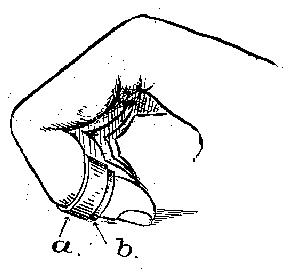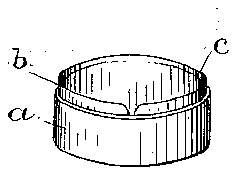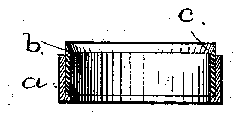


Description
No. 712,658. l Patented Nov. 4, |902.
' E. DELLWIG.
CORN FABER.
(Applicatin lqd Nov. 29, 1901.)
v (No Model.)
. C b. Y Cb.. I-l y!! 'ifJJ-CL l f1 17e/77511 Ntra drains ERICH DELIJWIG, OF SAN JOSE, CALIFORNIA.
CORN- PARER.
SPECIFATIUE forming part of Letters Patent No. 712,658, dated November 4, 1902.
Application filed November 29, IQQl. Serial No. 83.990` iNo model.)
To all whom, it may concern:
Be it known that I, ERICH DELLWIG, a citizen of the United States, residing at San Jose," in the county of Santa Clara and State of Cali-A fornia, have invented a new and useful Improvement in Corn-Parels, of which the following is a specification.
This invention has for its object the production of an improved device or instrument for paring corns and other growths on the feet, in which simplicity of construction and safety in operation are the leading features.
The said improvement consists in certain novel parts and combination of parts producing an instrument for the purpose mentioned, as hereinafter described, and set forth in the claims at the end of this specication, in which also reference is had to the accompanying drawings, forming part thereof.
Figure lis a perspective View of the device,
showing the manner of holding and operating the same. plement on au enlarged scale. transverse sectional View.
The device comprises a body a., formed of Fig. 3 is a a fiat ring, and a curved cutting-blade b, held.
stand a relatively short distance away from the finger when the ring and blade are placed thereon. I prefer to make the ring and the cutting-blade of separate' parts and to secure the latter in place by virtue of its curved shape and its inherent resiliency. This inode of construction allows the blade to be readily removed for sharpening or repairing and also permits the projection of the cutting edge above the ring to be increased or reduced in degree, as desired. For that purpose it is better to make the blade of a strip of steel of proper length to be bent into circular form and slipped into the ring, leaving the ends disconnected and slightly separated or not in actual contact, the resiliency of the blade when allowed to spring out and fill the ring being ordinarily sufficiently great to hold the blade in place ,without other fastenings. A
ledge or shoulder on the inside ot' the ring at Fig. 2 is a perspective of the im` or near the bottom is usually provided to remove any liability of the blade being forced back into the ring by any pressure that might be applied directly against the cutting edge inline with the plane of the blade. The continuous cylindricalshape of the cutting-blade herein shown is the one preferred for general purposes, for the reason that it provides a cutting edge of considerable length, allowing a fresh or new portion to be brought into play from Vtime to time simply by turning the ring around on the finger. It also enables the blade to be held in place without requiring special fastening means, such as pins or screws, and in a much more secure manner than would be possible it' the blade were a -seclion of a cylinder instead of a complete cylinder, as herein shown.
Fig. l of the drawings well represents the manner of holding andm operating the instrument. It is slipped over one of the fingers of the hand, generally the forenger, with the cutting edge turned outward or toward the tip of the nger. Then by bending the finger in toward the palm and setting the cutting edge against the corn the operation of paring is performed by moving the linger at the knuckle and the second joint, as in the act of opening and closing the finger on the palm, but with a relatively short stroke or motion, so as to keep the cutting edge closely to the corn and produce a movement resembling the stroke of razor. Vhen the ring is properly set on the finger, the blade will set at such an angle to the part orsurface to be operated on that a cutting or paring action, as distinguished from a scraping motion, will be produced. In this position it will be seen as that the cutters edge is concentric with the finger and is held at a fixed distance therefrom the finger itself performs the function of a guard, regulating the depth of penetration of the cutting edge and preventing the blade from cutting too deeply. This element of safety is one of the leading features of the instrument.
Having thus fully described mytinvention, what I claim as new therein, and desire to secureby Letters Patent, is-` l. In a corn-parer,a blade-holding ring,and a cutting-blade frictionally heldagainst the inner wall of said ring, the ring and cuttingblade adapted to encircle one of the fingers of IOO the user, and a cutting edge carried by said blade which projects beyond the edge of the ring, substantially as described.
2. In a corn-parer, an annular ring having an interior annular ledge,and an annular cutting-blade removably mounted in the ring with its annular cutting edge projecting beyond the ring and its'other edge engaging the annular ledge, substantially as described.
3. In a corn-parer, an annular ring, and an annular split cutting-blade frictionally held against the inner Wallof the ring and having its annular cutting edge projecting beyond the edge of the ring, substantially as described.
4. A corn-parer comprising an annular ring adapted to encircle one of the fingers of the ERICH DELLWIG.
Witnesses:
KARL KLEIN, JOHN B. KERWIN.